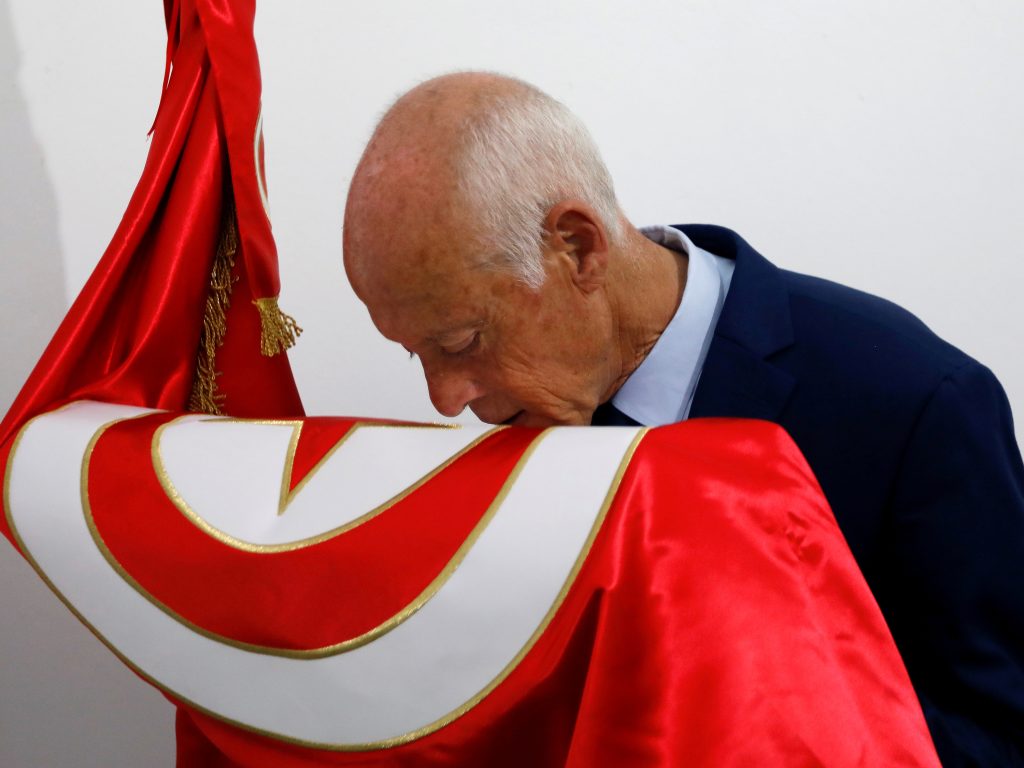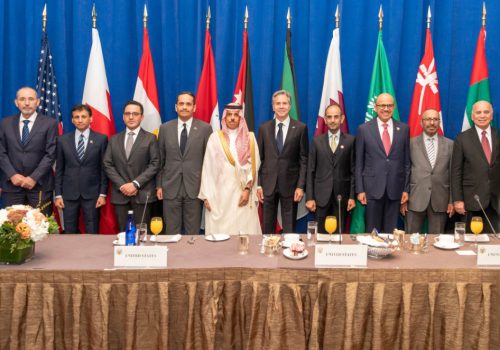Even before the conflict in Ukraine, the liberal state model looked much less attractive for the broader Middle East region than it had only a decade earlier, at the height of the Arab Spring. The failures of Western efforts in Iraq, Libya, and above all in Afghanistan, where there had been the greatest international attempt to create a state that could combine local traditions and liberal ideals, contributed to this shift in sentiment. A plurality of other factors played a role too. These include the political and economic crisis in Europe, which provoked the rise of populist movements; the tensions within the United States that erupted with the 2020 elections and the ensuing attack on the US Capitol on 6 January 2021; and the growing influence and popularity in the Middle East, of a China-like political model that appears to promise stability with economic growth at the expense of democratic values. Finally, the substantial failure of the Arab Spring, with the return of autocratic regimes or the outbreak of civil and proxy wars, further weakened the fading hopes of liberal movements in the region. For a long time, Tunisia had been seen as an exception in this geopolitical panorama. Yet recent events have shown the fragility of the Tunisian democratic model, and the deep contradictions that exist there in a post-2011 scenario.
Against this background, the war in Ukraine has exacerbated international tensions, further polarizing the “democracy vs autocracy” dichotomy. It has also highlighted Western contradictions and the differential attention the West is paying to Eastern Europe and the Middle East. Therefore, limited Middle Eastern support for the West’s positions in what appears to be simply a “European war” is understandable, in a multipolar context in which regional powers are trying to navigate between two competing blocs. Above all, the West’s concentrated attention to the war in Ukraine has left local actors in other regions ample room to maneuver boldly, as demonstrated by the recent moves made by Tunisian President Kais Saied.
How did we get to this point?
Saied’s 2019 election as president of Tunisia represented the victory of an anti-system, anti-elite rhetoric used by the candidate throughout his electoral campaign. His project, that was presented more like a messianic mission than a political or party agenda, had a simple set of slogans: “Purge” the country of the old political party system that had ruled Tunisia since the 1980s and is accused of being corrupt, elite-oriented and representative of feckless governance. Saied promised to erase the gap between citizens and decision-makers by reversing the pyramid of power through an institutional reform inspired by a vague, populist concept of sovereignty. The idea was to give more power to local representatives and to himself, as a guarantor of the interests of the people and the nation. Put simply, to “correct the revolutionary process”, a phrase that had already been sinisterly used by the post-2011 revolts’ regimes.
The principal scapegoat of Saied’s rhetoric was the Islamist party Ennahda, guilty of failing to find a solution to Tunisia’s social and economic problems despite holding the largest number of seats in parliament for much of the decade after the 2011 uprising. Nevertheless, the other parties were also in the dock, accused of not being able to create a stable economy and credible institutions.
The economic and health consequences of the Covid-19 pandemic pushed the country to the brink of collapse, leading the president to quickly implement his project. On 25 July 2021, with the support of the military and security forces, Saied declared a state of emergency, suspended parliament, and dismissed the prime minister. Parliament was later dissolved on 30 March 2022, by when the effects of the current war in Ukraine had compounded Tunisia’s crisis. During the following months, he imprisoned many political figures, particularly from Ennahda, and worked to consolidate authority in his own hands. The last step of this path was to call all Tunisians, on 25 July 2022, to the polls to vote on a new constitution which, while apparently designed to foster democracy, in reality might obtain the opposite result ‒ that is of establishing a “one-man rule”.
The new constitution, superseding the one established in 2014, has the hidden goal of ensuring that the authority Saied seized in July 2021 remains firmly in his hands, giving legal form to this status. Thus, the two main pillars of Saied’s project clearly emerged. Firstly, the aim is to expand the president’s powers by granting him control of the executive branch while weakening the authority of parliament and the judiciary. Secondly, the new constitution will emphasize a peculiar bottom-up process of political functioning.
Regarding the first goal, the president now has the power to appoint the prime minister, dismiss government, present draft laws to parliament, and appoint judges. In a word, the new constitution nullifies the institutional checks and balances system. Moreover, the president cannot be impeached.
As for the second aim, this constitution ratifies a new bottom-up system of representation. It theoretically empowers local leaders and assemblies at the expense of political parties, whose centralized influence is undermined. However, on looking deeper, it is clear that this system demonstrates a twofold strategy: to weaken political parties, organized movements, and so any structured opposition to the president; and more importantly, to maintain the real executive power completely in the hands of the president himself. This system gives the illusion of a popular power (resembling in some way the ideological aspiration of Muammar al-Qaddafi’s Libyan Jamahiryya), but seems to lack a real chain of transmission to power. In fact, the executive power that is tasked with implementing local and regional programs, considered to be the expression of the people’s will, is strongly concentrated in the hands of the president.
Were Tunisians aware of the changes introduced by the new constitution before the vote? According to observers, few of them had previously read the draft of the text, a fact that highlights how the 94.6 percent of “yes” votes (although the turnout was just around 30 percent) represents a vote against the political system, rather than a real consensus on the new constitution. Still, the vote confirms the presence of a persistent popular base for the president, while the exultation that welcomed the final referendum’s result underlines the failure of the boycott campaign launched by political parties and of the neutral stance adopted by Tunisian trade unions. The final picture is that of an extremely polarized and politically fragmented country.
The deep gap between, on the one hand, the majority of intellectuals and civil society activists ‒ who identify themselves as active actors in the “democratic transition” narrative ‒ and, on the other, a huge part of the Tunisian population, is a clear sign of this condition. Saied’s most fervent supporters appeared less concentrated on the draft constitution than on their experience of a decade of social degradation, a state that mistreats citizens, corrupt politicians, an unresolved cycle of debt and financial crisis, powerless and unstable governments characterized by permanent conflicts, and injustices of the state security-judicial apparatus. The “democratic transition” has been perceived by a large majority of Tunisians as a narrative of decline and not exalted as an ethos of collective emancipation after years of authoritarianism. Thus, “yes” votes represented the will to punish its definitive failure.
In this context, many feel the need for a “strongman” able to turn the tide, especially on the economic front, even if he has to exercise his role outside the normal democratic framework. This represents a double failure on the part of Tunisian political parties (and thus a double victory for Saied). On the one hand, the result of the referendum highlights their inability to adopt common actions and shared political agendas; on the other, it ratifies the continuous estrangement of the Tunisian people from political life. Saied’s success embodies the reaction to the paralysis that had gripped Tunisian political life. At the same time, this model produces a representative government pattern where citizens, considered just voters, abdicate their right to participate in public affairs, fueling a growing tendency to abstention from the political process and a distrust in intermediary figures such as parties. This framework paves the way for enhancing the authoritarian hold on the country.
Tunisia is now struggling with a disastrous economic situation: The unemployment rate is at 15.3 percent, with an annual official inflation rate of 8.2 percent. This has been aggravated by an imminent food crisis due to the Russian invasion of Ukraine, since Tunisia depends on the import of cereals, and its biggest wheat supplier is Ukraine, responsible for 41 percent of imports. All of this risks increasing the already high levels of poverty.
The country’s economic recovery will largely depend on Saied’s ability to secure a new International Monetary Fund (IMF) rescue package within this year in order to cover for the government’s inability to pay off country’s foreign debt. However, the ongoing negotiations for a $4 bn loan require two conditions: to realize a realistic reform strategy, involving political, business and union representatives, and to carry out austerity measures like freezing public sector wages, decreasing public sector salary expenditures, and reducing subsidies on essentials like food and energy. These are all harsh requirements for the Tunisian government to accept. As poverty increases, Saied and Prime Minister Najla Bouden, handpicked by the president last October after his removal of the earlier time minister, have little room for macro-economic maneuvers. There is a broad opposition to the IMF’s austerity measures, led by the powerful Tunisian trade unions, since they could aggravate the economic situation and further undermine the state’s capacity to drive economic growth.
This represents the fundamental test for Saied’s regime while a perfect storm unfolds on the horizon: the return of austerity measures, international pressures‒which are warning Saied of a serious risk of economic default without external financial aid‒and a growing political polarization followed by popular protests. In this framework, the ongoing conflict in Ukraine is a dangerous challenge since it is deeply affecting the economies of the Euro-Mediterranean region. Initially, Russia’s was diverted Western attention from the Mediterranean, but Saied cannot rely on this, since the United States and, to a lesser extent the European Union, have already threatened reductions in aid if the president does not put the country back on track.
If the “People’s President” wants to save the country and, at the same time, his popular support, he needs to understand that changing the constitution and political system will not solve Tunisia’s deep economic and social problems. He needs to abandon his accusatory rhetoric and launch an inclusive national dialogue that includes political organizations, trade unions, and social movements. This could be the only way to preserve what remains of Tunisia’s democratic project.
Alessia Melcangi is a nonresident senior fellow with the Atlantic Council’s Rafik Hariri Center & Middle East programs, Associate Research Fellow at the Middle East and North Africa Centre at the Institute for International Political Studies, and Associate Professor at Sapienza University of Rome.
Read more
Image: Presidential candidate Kais Saied kisses a Tunisian flag after unofficial results during the Tunisian presidential election in Tunis, Tunisia, September 15, 2019. REUTERS/Zoubeir Souissi TPX IMAGES OF THE DAY

